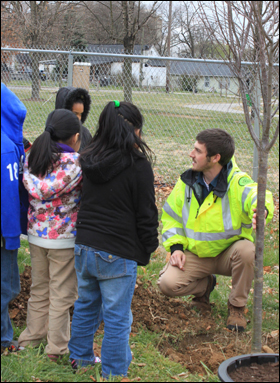We were joined on Tuesday by Kasey Krouse from the City of Knoxville. Kasey is the first ever Urban Forester for Knoxville.
Kasey started with a picture of Albuquerque, New Mexico, where people are planting trees. Trees are important to a community for 3 different benefits economic: landscaping draws people to a business or a place to live environmental: obvious social: reduction of stress in a community
Consider the economic impact that the Dogwood Arts Festival has had on Knoxville. Consider how your favorite trees in Knoxville inform your attitude about where you live. Trees are important to the air we breathe and the water we drink. Kasey came to Knoxville in 2012. He is the city’s urban forester. When he arrived, the ash tree was in deep trouble, and most of those had been wiped out. It was one of the first problems he had to deal with. Another was that people were doing volcano mulching around the base of their trees, which causes the tree to rot around the base. Others were doing tree-topping, which can be horrible for a tree as well.
The City responds to tree calls especially in heavy winds. They keep the roads cleared during this weather. They get odd calls as well. A bicycle in a tree. A car door stuck in a tree. Our environmental impacts are great. While they may not prevent wrecks against some of our trees, there are places where they can and do proactive management. For example, they go to each of the City’s 5 geographical areas and check the trees. Those areas are N,S,E,W and central.
Tree planting is only a small percentage of what they do. They stop planting in early March. They plant between 500-600 per year. They try to plan for uncertainty of the climate. There are 5 certified arborists on staff.
The office tries to bridge the public-private property question. Trees Knoxville attempts to do that as a non-profit organization. We want to increase the natural canopy of the city. They do volunteer tree plantings. They do Canopy for Campus. There, the aim is to do tree plantings on school grounds. They work with the staff and maintenance people at the schools.
In 2020, they began an urban tree canopy assessment. It was done by Trees Knoxville. We have about 38% tree canopy in Knoxville. 32% hard space. The rest is other space, such as lawns, parks and the like. Kasey shared a number of interesting slides showing what the assessment told us about the canopy. Some areas have 50% tree cover (south Knoxville). The lowest is downtown. Compared to other cities: Chattanooga 45%, Nashville is a metro area so it is hard to compare. Changes in the canopy were mapped. Some areas have tree losses while others have gains. Where losses are occurring, they try to do tree preservation measures. Other areas may be targeted for planting. Where tree cover is great, temperatures are lower, as much as 6 degrees. 6 degrees makes a big difference when setting a thermostat. Without that tree cover, cooling costs inside go up.
Urban Forest Master Plan was started last year with a lot of partners. (Think UT, the state, KUB, others) The plan has been released. See knoxvilletreeplan.org to see it. There were 80 different organizations working on the discovery process. Goals: more trees, better quality of greenspace, equitable across the entire community. Want 40% tree cover by 2040. We want diversifying the trees. We need to not have more kudzu, privet, etc. We want long life trees. Everyone should have access to green space and to trees. There are 9 strategies in the plan. They want more outreach, more collaboration, among other things.
We want a more livable green Knoxville. They would like it if you could see 4 native trees no matter what window you are looking out of in Knoxville. You can e-mail Kasey at the City if you have questions that were not answered. The first question was about Bradford pears. Kasey said Bradford pears fall apart, they smell, and they are invasive. They grow fast, they are cheap, they do provide shade. They are not good for our environment. They will not be striving to save any of those.

